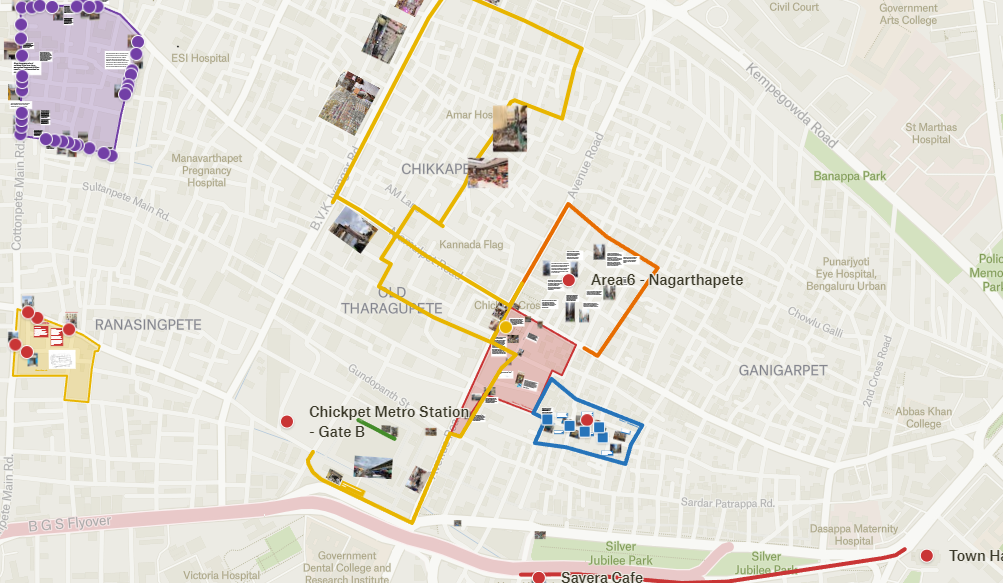Seeing, Being, Doing: design

This course description is for a learning program that I, along with Navin Kushwah and Naveen Bagalkot, jointly delivered to our 4th year Human-Centered Design (HCD) students.
See full map at Chickpet Field Visit - HCD Sem 7 — Felt
- The brief:
- Vibes:
- Student Projects:
- Course Content
- Modes of Engagement
- Capabilities
- Applications and Themes
The essence of our exploration lies beyond just human-centered design; it delves into the rich, often overlooked narratives of spaces where humans and non-humans converge. These spaces, termed “gathering-spaces,” serve as focal points where diverse actors collaborate to shape the environment and its functions. Our aim is to uncover how humans interact within these spaces, how their gatherings are influenced by the space itself, and the collective forces at play.
The goal was to explore the process of learning from, existing within, and crafting within gathering spaces. We used metaphors from these environments to shape a practice focused on Human-Centered Design (HCD). Students engaged in diverse activities such as site visits, mapping, reading, crafting, and collaborative work with peers.
The brief:
Adopt a method of learning to be, see and make in the spaces of gathering. Aim to understand the dynamics of human positioning within these environments. By employing auto-ethnographic design, immerse ourselves in these spaces, documenting what we perceive and what remains unseen. Through this process, we’ll unravel key questions:
- What can we learn from what we observe versus what we overlook in these spaces?
- How do we exist within these environments, both present and absent?
- As we engage in creative making, what insights do these spaces offer about ourselves and our design aspirations?
- What metaphors can we derive from these spaces, and how do we assess their relevance within the broader context of design history?
Our focus will be on cultivating multiple practices of situated making, leveraging the inherent qualities of gathering-spaces to inform our creative endeavors.
By critically evaluating the metaphors extracted from these environments, we aim to enrich our design practice while contributing to a deeper understanding of our relationship with space and its constituents.
Vibes:
Student Projects:
- Gathering Spaces - thetipsyartist.in
- Patchwork Pete - B•LORE by BIC - Atheeva
- the brown kid - The Pete Project playlist
- Recording a place : simplebooklet.com
- Pallavi Kiragi - Seeing, Doing, Being Design
- The monkey that did everything on his own - Malay
- Single Screen Theatres - Sakshi Joshi
- Making the Most of Field Research as an Introvert - Pronomika
Designing for Gathering Spaces is a course that moves beyond the confines of conventional Human-Centered Design (HCD) to consider the wider environment in which humans and non-human elements interact. It emphasizes on situated making and is taught in an interactive format involving active student engagement with diverse gathering spaces. The course takes a broad view of gathering spaces, incorporating both physical locations such as parks, urban environments, and workplaces, as well as digital spaces and ecosystems. Its approach acknowledges the co-presence of human and non-human actors, encompassing technology, animals, and natural features, among others.
Course Content
- Auto-ethnography and Design: Students learn to document and interpret their interactions within the space and its occupants.
- Understanding and Designing for Non-human Actors: This part covers how design can accommodate or interact with non-human entities such as urban infrastructure.
- The Nature of Gathering Spaces: Students explore the defining elements of gathering spaces and how they influence behaviours and interactions.
- Positionality in Space: This topic explores how different actors are positioned in these spaces and how that positioning influences interaction.
- Metaphorical Thinking in Design: The course investigates using metaphors derived from observed spaces for design thinking.
- Responsiveness in Design: This section promotes the design of solutions that adapt to the needs of all entities in a gathering space.
- Collaboration and Co-creation: Students are encouraged to collaborate with others, including non-human actors, in the design process.
Modes of Engagement
- Reading and Annotating: Students gain understanding of various histories, current scenarios, and narratives.
- Mapping and Seeing: This mode involves discovering and mapping distinct perspectives across various dimensions.
- Participating and Being: Encourages students to understand and experience various roles within a space.
- Making and Bridging: Focuses on the creation of artifacts as a means of communication and collective thinking.
- Archiving and Exhibiting: Students create archival artifacts that capture their engagements.
- Participatory and Collaborative: Students participate in shared decision-making and actions.
- Co-creating and Co-learning: This mode involves collaborative creation of artifacts or knowledge.
Capabilities
- Speculate: Constructing from concepts in the face of complexity, risk and limited information.
- See & Connect: Uncovering and synthesizing diverse experiences and forms of knowledge.
- Be Honest: Being self-aware and transparent in expressing one’s position.
- Make: Creating new artifacts, things, and relationships as tools of critical inquiry.
Applications and Themes
- Urban Ethnography and Place-making: Exploring spaces in urban environments and understanding how individuals and communities interact with and shape their environment.
- Narrative and Experience Design: Documenting experiences and observations to create compelling narratives that convey the unique characteristics of different places.
- Research Methodologies in Design: Applying primary research techniques like field notes, sketching, interviews, and sound recordings in real-world settings.
- Cultural and Historical Documentation: Focusing on documentation and preservation of cultural and historical elements of spaces.
- Design Artifacts and Installation: Translating research and observations into tangible design artifacts or installations.
